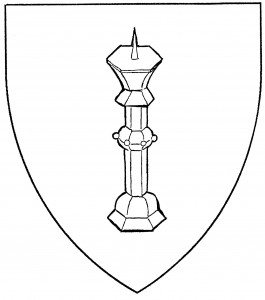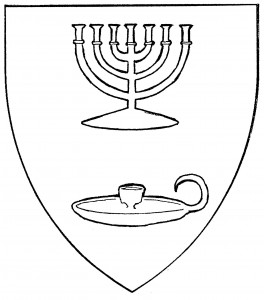A candlestick is a cupped or spiked metal holder for a candle. It’s a period charge, found in the arms of Kyle, 1542 [Lindsay], and of the Worshipful Company of Founders, 1590 [Bromley & Child 99].
The default candlestick is an ornate column, spiked on top; it is palewise by default. If a candle is mounted in the candlestick, the fact is explicitly blazoned.
Of variant forms of candlestick, there is the “candelabrum”, a multi-armed candlestick, found in the arms of von Krage, 1605 [Siebmacher 151]. The number of arms is frequently blazoned, especially when five or fewer; three arms seem most common. If the candelabrum has seven or nine arms, it may also be blazoned a “menorah”, used in some Jewish ceremonies; the illustration shows a period form with seven arms, but both forms have been registered. The “morter” or “mortcour” is a mortuary candlestick, highly ornamented, for use at funerals; it’s found in the arms of the Worshipful Company of Wax Chandlers, 1484 [Bromley & Child 259]. Finally, Society armory has the “flat candlestick” or “sconce”, a shallow dish with a handle.
Gilraen of Regen bears: Vert, a candle and candlestick flamant Or.
Louise of Woodsholme bears: Per fess embattled gules and erminois, in base a candle argent in a flat candlestick sable, enflamed proper.
Uilliam of Bronzehelm bears: Sable, a three-armed candelabra lit Or.
Edwin the Unwyse bears: Argent, a menorah sable.
Illuminada Eugenia de Guadalupe y Godoy bears as a badge: A mortcour Or.

